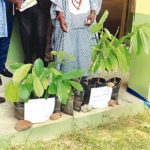Minor wounds, cuts, and burns are an unfortunate, but unavoidable part of life. However, for people with diabetes, these injuries can lead to serious health issues. Many people with diabetes develop wounds that are slow to heal, do not heal well, or never heal. Sometimes, an infection might develop.
In some cases, and without emergency care, an infection can be life-threatening or may even be fatal. Even when an infection does not develop in a wound, slow healing can adversely affect a person’s overall health and quality of life. Cuts or injuries on the feet or legs can make walking difficult or exercise painful.
Now, experts investigating the wound healing potential of mango stem bark say it has the ability to promote wound healing in diabetic rats. It accelerates the wound healing process, and hence, it could be possibly used as a topical wound dressing material.
Despite the common use of mango fruit as a food item, various parts of mango trees have also been used for medical purposes since ancient times. Mango stem bark has been found to have an ameliorative role include for toothache, gastrointestinal disorders, respiratory tract infections, urinary tract infections and anemia. Resins of the mango bark have been used for the treatment of cracked skin and feet.
In the new study, the excised wounds of diabetic adult female wistar rats in groups of six were dressed with mango bark powder (MPD), mango bark ethanolic extract (MED), sofratulle (SD) and normal saline (ND) daily till healed. The powder formulation of the bark proved to be better wound dressing material than the ethanolic extract.
The study in the 2020 edition of the Journal of Complementary and Alternative Medical Research involved Rotimi Sunday Ajani and Opeyemi Jeremiah Olateju, both at the College of Medicine, University of Ibadan, Nigeria.
Every three days, the mean wound contraction rates were calculated from the measured wound areas. Granulation tissue was biopsied from an animal per group on day 3, 6 and 9 for evaluation and after healing, the scars of the remaining animals were biopsied for histology. Wound healing had progressed satisfactorily in all the groups (control and diabetic) by day 15 and the mango bark ethanolic extract (MED) had the least rate of 82 per cent.
Comparisons between the MPD group and the other diabetic groups on day 3 revealed that the average wound contraction rate of the former was significantly higher than those of the latter groups. According to them, the mango bark powder groups (control and diabetic) had the highest average wound contraction rates and followed up by the mango extract groups due to the non-essential oil compounds of the mango bark.
The researchers suggested that the mango stem bark promotes wound healing in diabetic wistar rats by enhancing collagen synthesis, reducing the inflammatory process (anti-inflammatory components), and reducing cellular oxidation (anti-oxidants constituents).
They, however, declared: “This observation becomes very pertinent when the ease of preparation of the two formulations is considered as the preparation of the powder is less technically demanding and with reduced cost. Thus, if this finding becomes translated to management of human diabetic foot ulcer, it is likely to be more receptive in terms of cost and application.
“If further researches on diabetic human subjects are able to corroborate this finding, there will be significant reduction in the management of diabetic foot ulcers in terms of cost and manpower. This will translate to reduced morbidity and mortality from diabetic foot ulcers and consequently improve quality of life.”
Previously, the researchers also suggested unripe mango pulp and rind as novel therapy for diabetic wounds. In the 2020 edition of the Journal of Complementary and Alternative Medical Research, they said the mango parts may serve as substitutes to sofratulle in the management of wounds with diabetic co-morbidity.
To investigate the wound healing benefits of the pulp and rind of the unripe mango fruit, the wounds of 24 diabetic rats in four equal groups were dressed respectively with unripe mango pulp extract, unripe mango rind extract, sofratulle and normal saline till healed.
According to the study, the extracts of unripe mango pulp and rind, when used as wound dressing materials, had the same end point comparable to those of sofratulle and normal saline in diabetic wistar rats.
Moreover, research on pawpaw revealed it beneficial for the treatment of wounds in diabetes. Experts checked the wound curing nature of pawpaw fruit extract in streptozotocin induced diabetic rats, and said it increases the wound curing rate. Its healing property is due to papain, an enzyme that helps in curing of the wound, and prevents the wounds from getting bigger.
YOU SHOULD NOT MISS THESE HEADLINES FROM NIGERIAN TRIBUNE
We Have Not Had Water Supply In Months ― Abeokuta Residents
In spite of the huge investment in the water sector by the government and international organisations, water scarcity has grown to become a perennial nightmare for residents of Abeokuta, the Ogun State capital. This report x-rays the lives and experiences of residents in getting clean, potable and affordable water amidst the surge of COVID-19 cases in the state.






